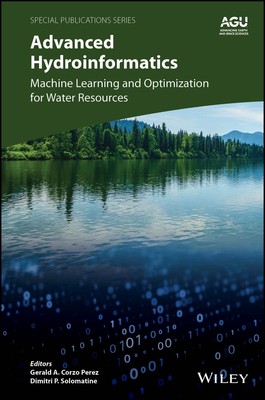
- We will send in 10–14 business days.
- Publisher: American Geophysical Union
- ISBN-10: 111963931X
- ISBN-13: 9781119639312
- Format: 15.8 x 23.1 x 3.1 cm, kieti viršeliai
- Language: English
- SAVE -10% with code: EXTRA
Hydroinformatics (e-book) (used book) | bookbook.eu
Reviews
Description
World water resources are under stress, and climate change, unplanned urban and rural development have generated the need for new approaches in problem-solving. Large organizations and many countries have focused efforts on the idea of data collection and open data policies. However, still many countries do lack knowledge on how to optimize the use of data. Physical and engineering formulations have been developed on the concepts of representation and limitations of data. However, nowadays, data-driven or machine learning concepts can be applied to many water resources problems.
The availability of a large amount of data (big data), including satellite products, global numerical weather models and integrated data sets with local measurements, has made it essential to be able to learn more about information extraction and use. Using Machine learning, in many data problems, has proven to be more accurate and faster than physical models. However, still more work is needed in the representation of solutions and uncertainty reduction, via the used combined physics and better analysis of the machine learning results. which allows for a better understanding. This combined information has been developing slowly, and since more than a decade machine learning problems have developed including more and more information from physics in the process of solving a problem. There are very few books dealing with the combined use of advanced machine learning and state of the art experiences in water resources. Hydroinformatics: Analysis, Modeling, and Forecasting would lay in the area of hydroinformatics and will include modeling and machine learning problems theory and examples, covering advanced computational algorithm for classification and regression problems.
Volume highlights include:
Hydroinformatics, Modelling and machine learning theory in water resources
Predicting extreme spatiotemporal hydrometeorological phenomena using machine learning
General applications of machine learning to optimal management, monitoring and use of water resources
EXTRA 10 % discount with code: EXTRA
The promotion ends in 21d.10:22:43
The discount code is valid when purchasing from 10 €. Discounts do not stack.
- Publisher: American Geophysical Union
- ISBN-10: 111963931X
- ISBN-13: 9781119639312
- Format: 15.8 x 23.1 x 3.1 cm, kieti viršeliai
- Language: English English
World water resources are under stress, and climate change, unplanned urban and rural development have generated the need for new approaches in problem-solving. Large organizations and many countries have focused efforts on the idea of data collection and open data policies. However, still many countries do lack knowledge on how to optimize the use of data. Physical and engineering formulations have been developed on the concepts of representation and limitations of data. However, nowadays, data-driven or machine learning concepts can be applied to many water resources problems.
The availability of a large amount of data (big data), including satellite products, global numerical weather models and integrated data sets with local measurements, has made it essential to be able to learn more about information extraction and use. Using Machine learning, in many data problems, has proven to be more accurate and faster than physical models. However, still more work is needed in the representation of solutions and uncertainty reduction, via the used combined physics and better analysis of the machine learning results. which allows for a better understanding. This combined information has been developing slowly, and since more than a decade machine learning problems have developed including more and more information from physics in the process of solving a problem. There are very few books dealing with the combined use of advanced machine learning and state of the art experiences in water resources. Hydroinformatics: Analysis, Modeling, and Forecasting would lay in the area of hydroinformatics and will include modeling and machine learning problems theory and examples, covering advanced computational algorithm for classification and regression problems.
Volume highlights include:
Hydroinformatics, Modelling and machine learning theory in water resources
Predicting extreme spatiotemporal hydrometeorological phenomena using machine learning
General applications of machine learning to optimal management, monitoring and use of water resources


Reviews